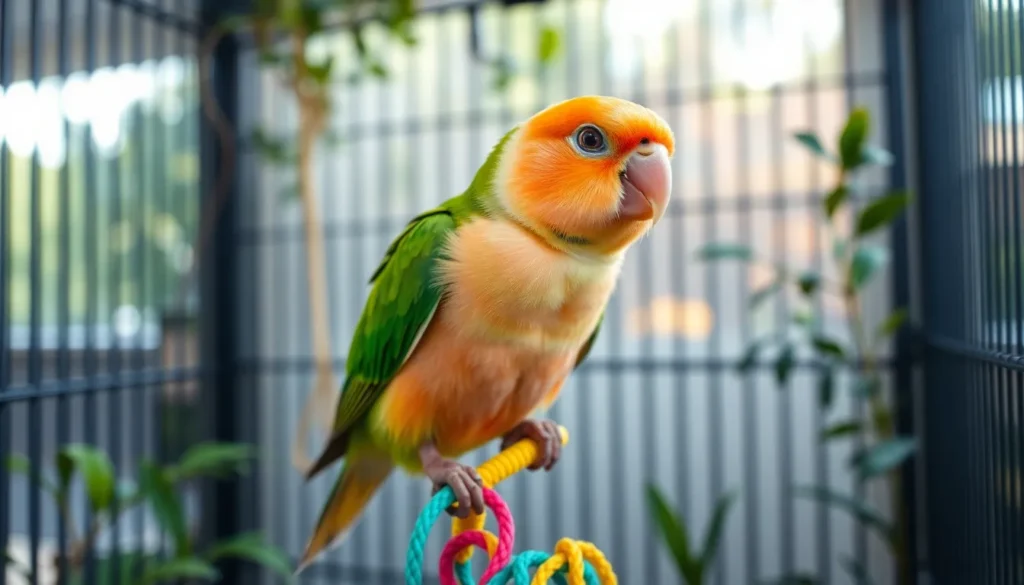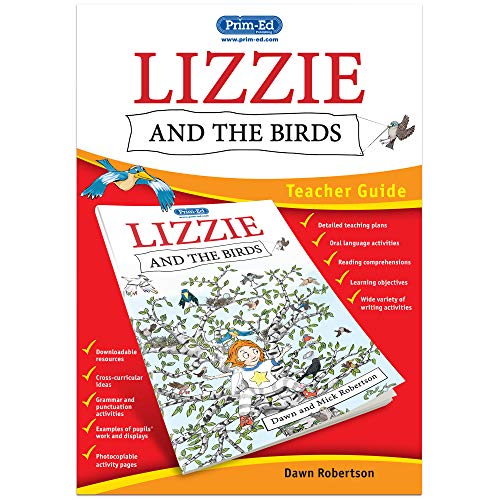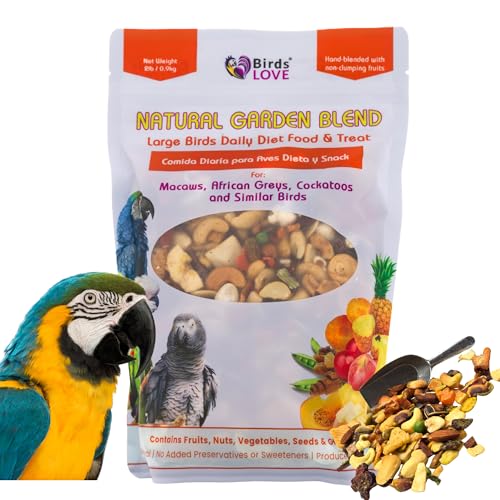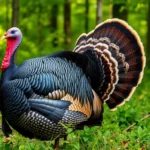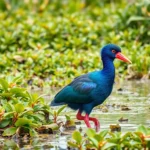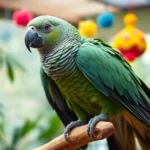Love birds capture our hearts with their vibrant colors and affectionate nature. These small parrots have earned their romantic nickname through their tendency to bond closely with their mates and display tender behaviors that mirror human expressions of love. Whether you’re considering adding these charming companions to your home or you’re simply fascinated by their unique characteristics, understanding love birds opens up a industry of avian wonder.
We’ve discovered that love birds aren’t just beautiful pets – they’re complex creatures with fascinating social behaviors and exact care requirements. Their playful personalities and strong pair bonds make them captivating subjects for both experienced bird enthusiasts and curious newcomers alike.
From their origins in Africa to their popularity as household companions today, love birds continue to enchant us with their spirited nature and remarkable intelligence. Let’s explore what makes these colorful parrots such extraordinary creatures and why they’ve become beloved members of countless families worldwide.
What Are Love Birds?
Love birds are small, vibrant parrots belonging to the genus Agapornis that captivate pet owners with their colorful plumage and devoted pair bonding behaviors. These compact birds measure 5 to 7 inches in length and display remarkable intelligence alongside their affectionate dispositions.
Physical Characteristics and Appearance
Love birds showcase brilliant color combinations that vary dramatically across their 9 distinct species. Peach-faced lovebirds feature bright green bodies with salmon-colored faces and blue flight feathers. Fischer’s lovebirds display emerald green plumage with orange-red faces and bright blue rumps. Masked lovebirds present striking black heads contrasting against yellow collars and green wings.
Their compact bodies weigh between 1.5 to 2.5 ounces with sturdy beaks designed for cracking seeds and nuts. Short, rounded tails complement their stocky build while providing excellent maneuverability during flight. Males and females appear nearly identical in most species, making visual gender identification challenging without DNA testing or behavioral observation during breeding season.
Strong zygodactyl feet feature two toes facing forward and two backward, enabling exceptional gripping ability for climbing and manipulating objects. Their curved beaks range from coral-red to bright orange depending on the species, serving as both feeding tools and display features during courtship rituals.
Natural Habitat and Origins
Love birds originate exclusively from Africa, inhabiting diverse ecosystems across the continent from dry savannas to tropical forests. Eight of the nine species call Africa home, while the Madagascar lovebird remains endemic to that island nation. These adaptable birds thrive in elevations ranging from sea level to 6,500 feet above sea level.
Wild populations favor acacia woodlands, grasslands with scattered trees, and forest edges where they access abundant seed sources. Peach-faced lovebirds occupy the arid regions of southwestern Africa including Namibia and southern Angola. Fischer’s lovebirds concentrate in northern Tanzania around Lake Victoria’s shores and extending into Rwanda and Burundi.
Seasonal migrations occur in response to rainfall patterns and food availability, with flocks traveling hundreds of miles to locate optimal breeding and feeding grounds. These social birds form communities of 10 to 100 individuals outside breeding season, roosting together in tree cavities and abandoned structures for protection and warmth.
Human development has impacted wild populations through habitat destruction and capture for the pet trade, though several species maintain stable numbers in protected reserves and national parks across their native ranges.
Popular Love Bird Species
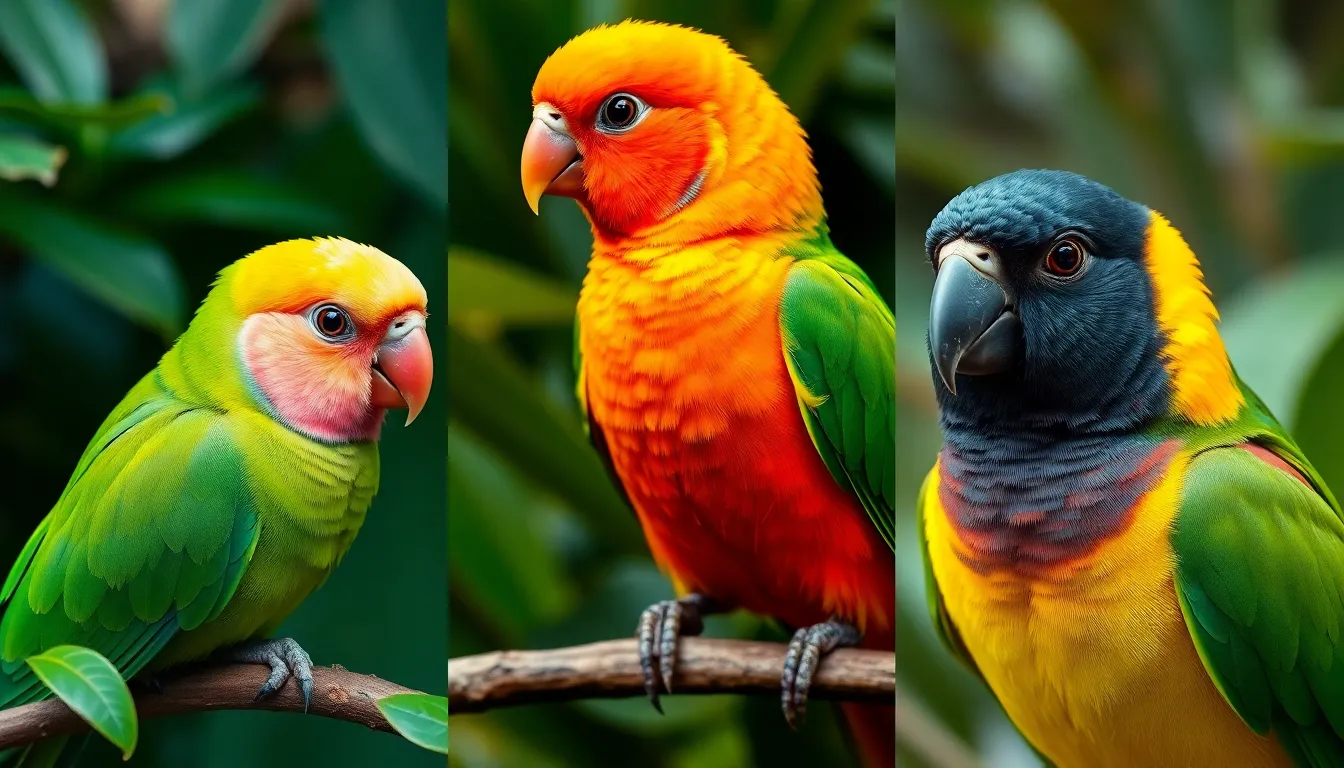
The nine lovebird species offer remarkable diversity in appearance and temperament, though only a few have gained widespread popularity in the pet trade. Three species dominate the companion bird market due to their adaptability, striking colors, and captivating personalities.
Peach-Faced Lovebirds
Peach-faced lovebirds (Agapornis roseicollis) represent the most common species in captivity, measuring 6 to 7 inches in length. Their distinctive peachy pink faces contrast beautifully with bright green bodies and blue flight feathers. These hardy birds originate from southwestern Africa, particularly the Kalahari Desert region of Namibia and southern Angola.
Color mutations in peach-faced lovebirds create stunning variations including lutino, pied, and blue varieties. Breeders have developed over 20 color combinations, making these birds particularly appealing to collectors. Their robust constitution allows them to adapt well to various climates and housing conditions.
Social dynamics among peach-faced lovebirds involve complex hierarchies and strong pair bonds that last throughout their 15 to 20 year lifespan. Males perform elaborate courtship displays, including head bobbing and regurgitation feeding behaviors. Females demonstrate nesting instincts by tucking strips of paper or other materials into their tail feathers.
Fischer’s Lovebirds
Fischer’s lovebirds (Agapornis fischeri) showcase vibrant orange heads that fade to yellow at the throat, complemented by green bodies and blue rumps. These 5.5 inch birds inhabit the south and southeast shores of Lake Victoria in northern Tanzania. Their distinctive white eye rings create a masked appearance that distinguishes them from other species.
Breeding Fischer’s lovebirds requires exact conditions including temperatures between 70 to 80°F and humidity levels around 60 percent. Pairs construct elaborate nests using twigs, bark, and leaves, with females laying 3 to 5 eggs per clutch. Incubation lasts 23 days, and chicks fledge approximately 38 to 42 days after hatching.
Wild populations of Fischer’s lovebirds face habitat pressures from agricultural expansion and capture for the pet trade. Conservation efforts focus on protecting nesting sites and regulating export quotas. Captive breeding programs maintain genetic diversity and reduce pressure on wild populations.
Masked Lovebirds
Masked lovebirds (Agapornis personatus) feature striking black heads with bright yellow collars and green bodies measuring 5.5 to 6 inches. Native to northeast Tanzania, these birds inhabit acacia woodlands and cultivated areas at elevations up to 5,900 feet. Their scientific name “personatus” refers to the mask-like black facial coloring.
Blue mutation masked lovebirds display cobalt blue bodies while retaining the characteristic black head and white eye rings. Other color variations include violet, slate, and dilute mutations that create softer color tones. These genetic variations occur naturally but selective breeding enhances exact traits.
Dietary preferences of masked lovebirds include grass seeds, millet, sunflower seeds, and various fruits like figs and baobab. Wild flocks gather at water sources during dry seasons and disperse across territories during breeding periods from January to July. Captive birds thrive on pelleted diets supplemented with fresh vegetables and limited seed portions.
Love Bird Behavior and Personality
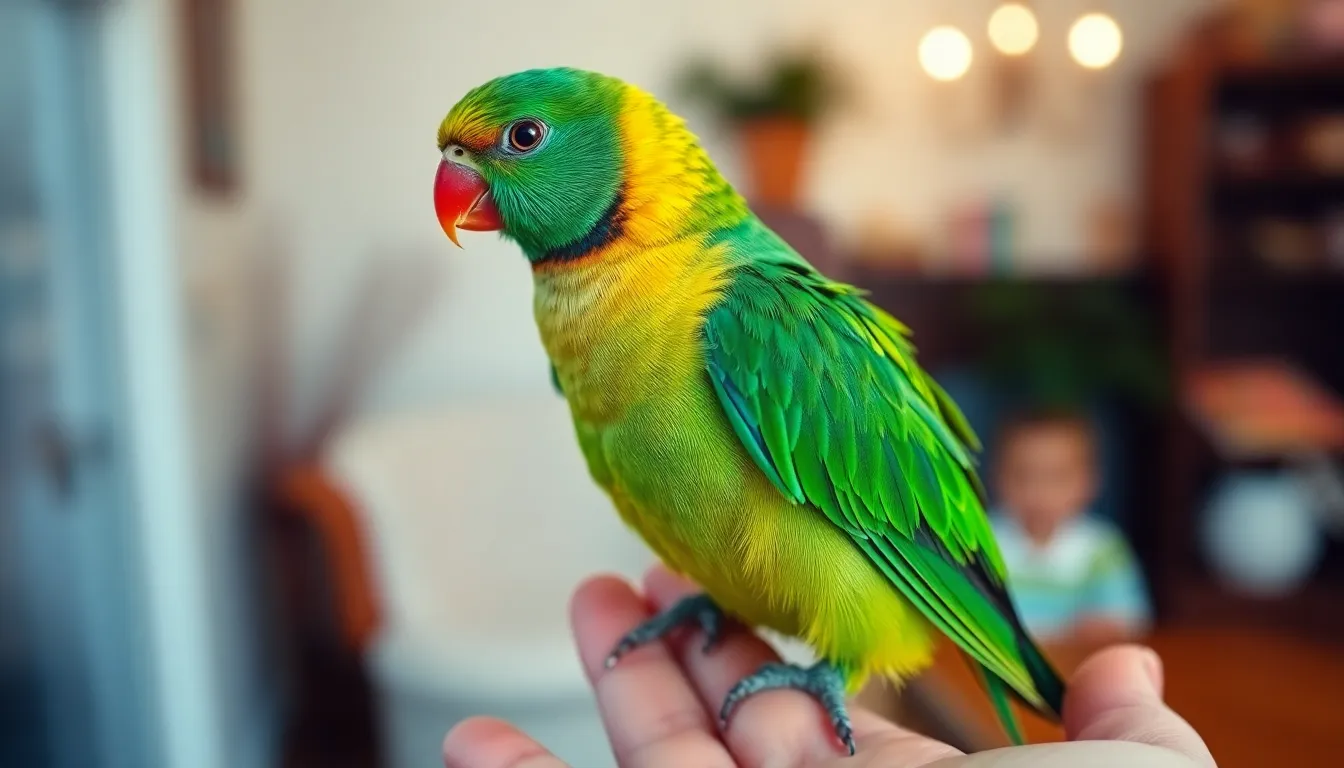
Love birds exhibit complex behavioral patterns that make them fascinating companions for bird enthusiasts. These small parrots demonstrate remarkable intelligence through their social interactions and communication methods.
Social Nature and Bonding
Love birds form monogamous partnerships that last their entire lifetime, typically 10 to 15 years in captivity. Bonded pairs engage in mutual preening, feeding each other, and sleeping close together as displays of affection. Single love birds in captivity often bond strongly with their human caretakers, seeking attention for 2 to 3 hours daily.
Flock dynamics play a crucial role in their natural behavior patterns. Wild love birds travel in groups of 20 to 100 individuals, establishing hierarchies through gentle nibbling and positioning behaviors. Pet love birds maintain these instincts by showing preference for elevated perches and exact roosting spots within their cages.
Territorial behaviors emerge when love birds establish their living spaces. Males typically defend areas measuring 3 to 4 square feet around their nesting sites. Females select nesting materials like paper strips, cloth fibers, and small twigs to create secure environments for their offspring.
Vocalization and Communication
Love birds produce distinct vocalizations that range from soft chirping to loud squawking, with frequency levels reaching 65 to 75 decibels. Contact calls help bonded pairs locate each other across distances up to 200 meters in natural settings. These calls occur most frequently during dawn and dusk periods.
Body language serves as their primary communication method beyond vocalizations. Head bobbing indicates excitement or greeting behavior, while wing flapping demonstrates territorial claims or mating readiness. Feather positioning reveals emotional states, with fluffed feathers signaling contentment and sleek feathers indicating alertness.
Mimicry capabilities vary among love bird species, with some individuals learning 10 to 15 human words or phrases. Peach-faced love birds show the strongest aptitude for vocal learning, while Fischer’s love birds excel at imitating household sounds like telephone rings and door bells. Training sessions lasting 10 to 15 minutes twice daily produce optimal learning results for most love birds.
Housing Requirements for Love Birds
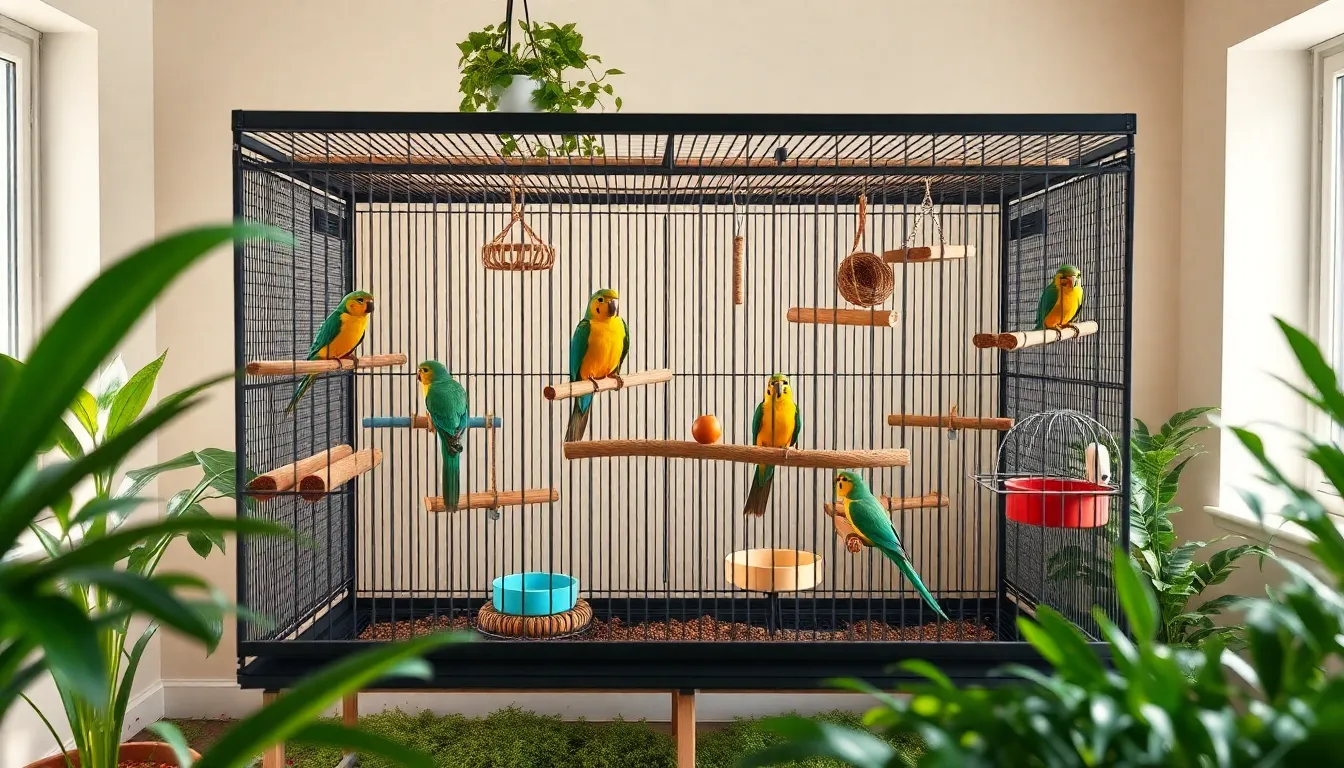
Creating the right living environment significantly impacts love bird health and happiness. Proper housing accommodates their active nature and social behaviors while ensuring safety and comfort.
Cage Size and Setup
Love birds require spacious cages that allow natural movement patterns and exercise. We recommend minimum dimensions of 24 inches wide by 24 inches deep by 30 inches high for a single bird, with larger spaces preferred for pairs. The cage width takes priority over height since love birds fly horizontally rather than vertically in their natural habitat.
Bar spacing measures between 0.5 to 0.625 inches to prevent escapes while allowing proper ventilation. Stainless steel or powder coated cages resist corrosion and provide durability against their strong beaks. We position perches at varying heights using natural wood branches like apple, willow, or birch to promote foot health and prevent arthritis.
Essential cage accessories include:
- Multiple food and water dishes positioned away from perches
- Cuttlebone or mineral blocks for calcium supplementation
- Interactive toys rotated weekly to prevent boredom
- Nesting boxes for breeding pairs measuring 8x8x12 inches
Daily cage maintenance involves removing uneaten food, refreshing water, and spot cleaning soiled areas. We perform thorough weekly cleanings using bird safe disinfectants to maintain hygiene standards.
Environmental Needs
Temperature control maintains love bird comfort between 65 to 80 degrees Fahrenheit with minimal fluctuations. Sudden temperature changes stress birds and compromise immune systems. We avoid placing cages near heating vents, air conditioners, or drafty windows that create temperature variations.
Lighting schedules mimic natural daylight patterns with 10 to 12 hours of bright light followed by complete darkness for rest. Full spectrum LED lights benefit indoor birds lacking access to natural sunlight. We cover cages with breathable fabric during designated sleep periods to ensure uninterrupted rest cycles.
Humidity levels between 50 to 60 percent support respiratory health and feather condition. Dry indoor air requires humidifiers or regular misting with clean water. Kitchen and bathroom locations expose birds to harmful fumes from cleaning products, nonstick cookware, and aerosols that damage sensitive respiratory systems.
We position cages in social areas where love birds observe family activities while maintaining quiet retreat spaces. Air circulation prevents stagnant conditions without creating direct drafts that chill birds. Regular out of cage time in bird proofed rooms satisfies exercise requirements and strengthens human bonds.
Love Bird Diet and Nutrition
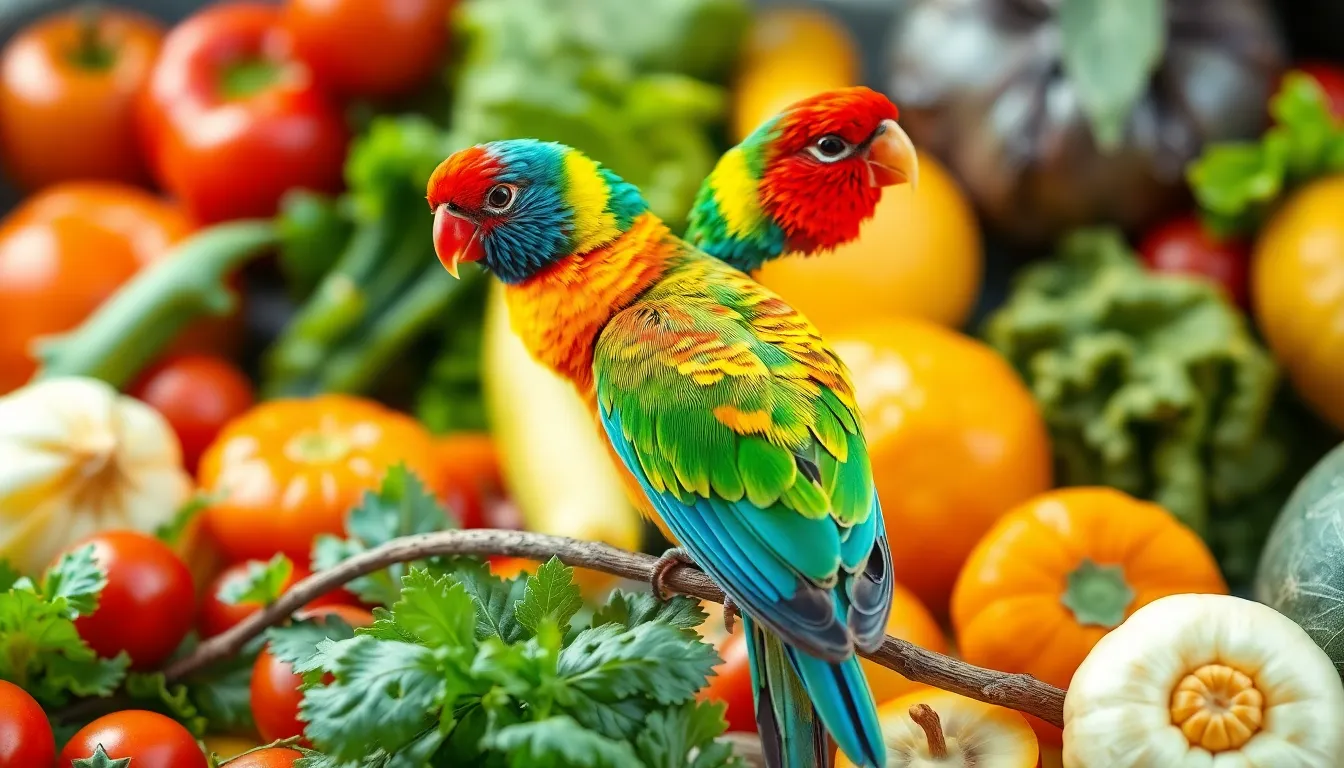
Love birds thrive on a diverse diet that mirrors their natural feeding habits in African ecosystems. Proper nutrition forms the foundation of their health and longevity in captivity.
Essential Foods and Supplements
Pellets constitute the core of a love bird’s daily nutrition and provide balanced vitamins and minerals. High-quality commercial pellets contain 14-18% protein and essential amino acids that support their active metabolism. We recommend offering 1-2 tablespoons of pellets per bird daily as the primary food source.
Fresh vegetables complement pellets and deliver vital nutrients that captive birds often lack. Dark leafy greens like kale, spinach, and Swiss chard supply calcium and vitamin A for strong bones and vibrant plumage. Orange vegetables such as carrots, sweet potatoes, and bell peppers boost immune function through beta-carotene content.
Seeds serve as treats rather than staple foods in a balanced love bird diet. Sunflower seeds, millet spray, and safflower seeds provide healthy fats but contain excessive calories when offered unlimited. Limiting seed portions to 1 teaspoon per bird prevents obesity and nutritional imbalances.
Fruits offer natural sugars and antioxidants that love birds enjoy in moderation. Apples, berries, melons, and grapes make excellent choices when served 2-3 times weekly. Remove seeds from apples and stone fruits before serving to prevent toxicity.
Calcium supplements become necessary for breeding pairs and egg-laying females. Cuttlebone, mineral blocks, and crushed eggshells provide additional calcium beyond dietary sources. Fresh water requires daily changes and clean containers to prevent bacterial growth.
Foods to Avoid
Chocolate contains theobromine and caffeine that prove toxic to love birds’ nervous systems. Even small amounts cause seizures, heart problems, and death in these small parrots. Dark chocolate poses greater risks than milk chocolate due to higher concentration levels.
Avocado flesh and pits contain persin, a compound that damages love birds’ hearts and respiratory systems. All varieties of avocado remain dangerous regardless of ripeness or preparation method. Guacamole and foods containing avocado also present serious health risks.
Caffeine from coffee, tea, and energy drinks disrupts love birds’ cardiac rhythms and causes hyperactivity. Secondary exposure through caffeinated beverages or grounds creates similar toxic effects. Alcohol produces liver damage and central nervous system depression in birds.
Salt and sugary foods overwhelm love birds’ kidneys and digestive systems respectively. Processed snacks, candy, and human desserts contain excessive sodium or artificial sweeteners that birds cannot metabolize. Xylitol, commonly found in sugar-free products, causes rapid insulin release and liver failure.
Fruit pits from cherries, apricots, and peaches release cyanide when broken or digested. Apple seeds contain similar compounds that become toxic in larger quantities. Raw beans and legumes contain lectins that interfere with nutrient absorption and cause digestive upset.
Health and Veterinary Care
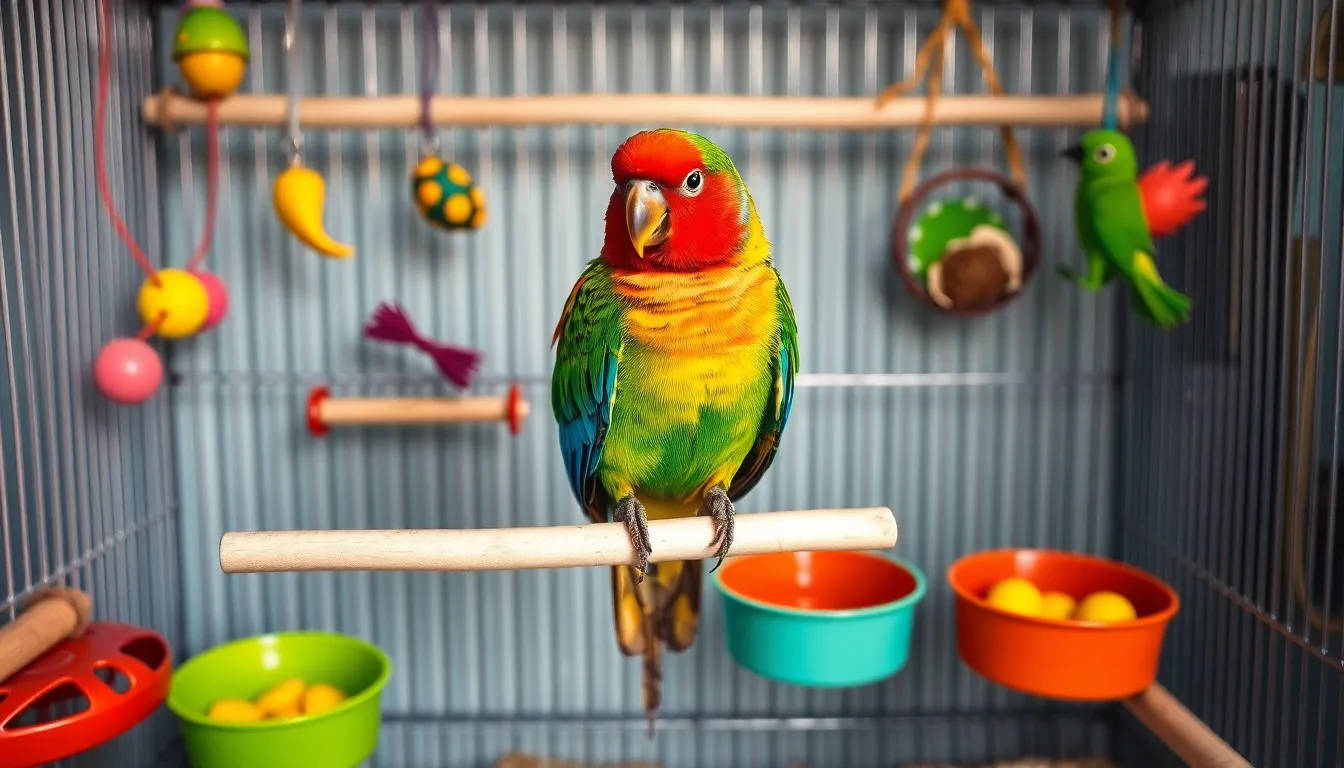
Love bird health requires attentive monitoring and proactive care to ensure these vibrant companions live long, healthy lives. Regular veterinary checkups and awareness of common health issues help us maintain our birds’ wellbeing.
Common Health Issues
Respiratory infections affect love birds frequently, particularly when exposed to drafts or sudden temperature changes. Signs include labored breathing, tail bobbing, and nasal discharge that owners can observe during daily interactions.
Psittacine Beak and Feather Disease (PBFD) presents as a viral condition causing feather loss, beak deformities, and immune system compromise. This progressive disease spreads through feather dust and requires immediate veterinary attention for proper diagnosis.
Egg binding occurs when female love birds cannot pass eggs naturally, creating a life-threatening emergency. Symptoms include straining, sitting on the cage bottom, and visible distress that demands urgent professional intervention.
Nutritional deficiencies manifest through various symptoms including poor feather quality, lethargy, and reproductive problems. Vitamin A deficiency particularly impacts love birds fed seed-only diets, leading to respiratory and eye infections.
Crop stasis develops when food remains in the crop too long, often caused by bacterial infections or feeding temperature issues. Young hand-fed birds face higher risk, with symptoms including vomiting and crop emptying delays.
| Health Issue | Primary Symptoms | Urgency Level |
|---|---|---|
| Respiratory Infection | Labored breathing, tail bobbing | High |
| PBFD | Feather loss, beak deformities | Critical |
| Egg Binding | Straining, sitting low | Emergency |
| Vitamin A Deficiency | Poor feathers, eye discharge | Moderate |
| Crop Stasis | Vomiting, delayed emptying | High |
Preventive Care Tips
Annual veterinary examinations establish baseline health parameters and catch problems before they become serious. Avian veterinarians perform comprehensive physical exams, weight checks, and blood work when indicated.
Quarantine protocols protect existing birds when introducing new love birds to the household. New arrivals require 30-45 days of isolation with separate air circulation to prevent disease transmission.
Environmental hygiene maintains love bird health through daily cage cleaning and weekly deep sanitization. Food and water dishes require daily washing, while perches and toys benefit from regular rotation and cleaning.
Temperature stability prevents stress-related illness by maintaining ambient temperatures between 68-78°F. Sudden temperature fluctuations compromise immune systems and increase susceptibility to respiratory infections.
Proper lighting supports natural circadian rhythms through 10-12 hours of natural or full-spectrum artificial light daily. Consistent light cycles regulate hormones and prevent behavioral issues associated with breeding triggers.
Stress reduction involves maintaining quiet environments during sleep hours and providing consistent daily routines. Love birds thrive with predictable schedules for feeding, interaction, and cage maintenance activities.
Weight monitoring catches health changes early through weekly weigh-ins using gram scales. Weight loss exceeding 10% of baseline indicates potential illness requiring veterinary evaluation.
Breeding Love Birds
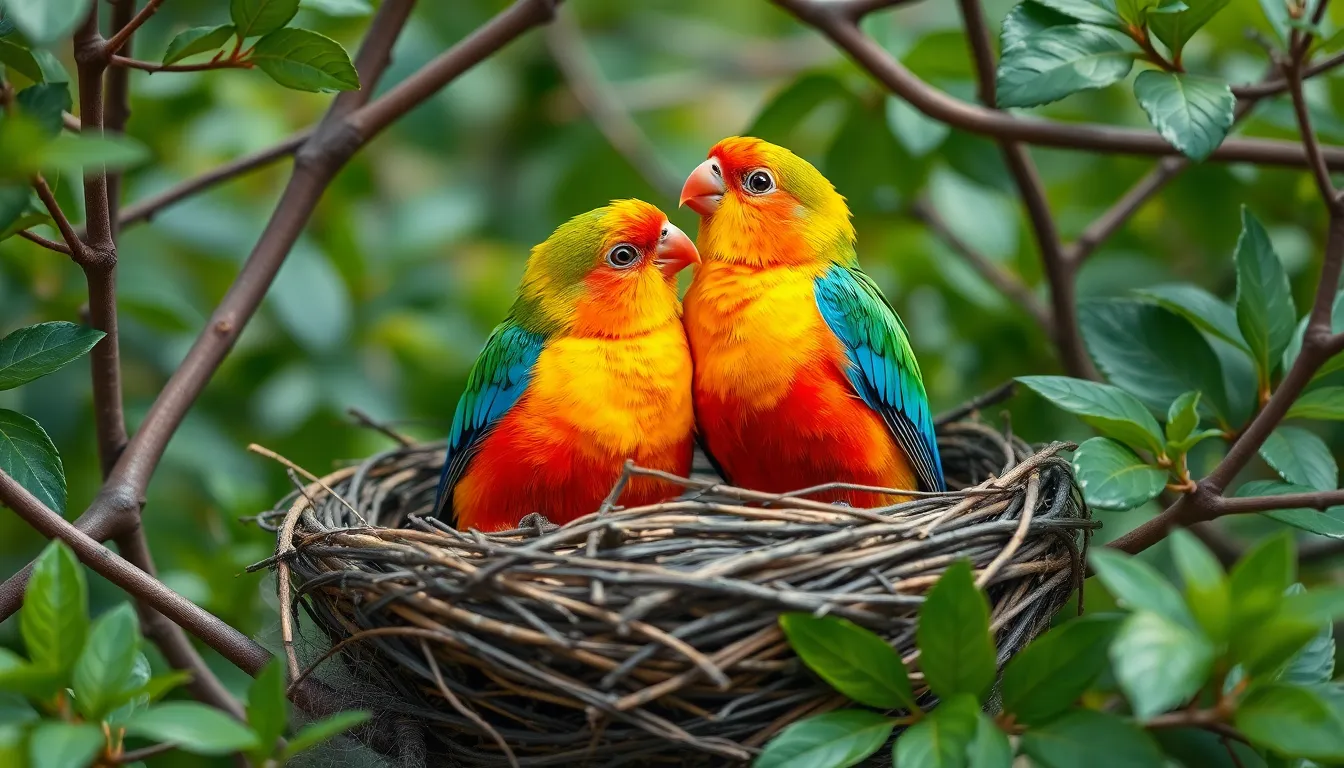
Breeding love birds requires careful planning and understanding of their complex reproductive behaviors. We observe fascinating rituals and dedicated parental care that make these small parrots exceptional breeders in both wild and captive environments.
Mating Behavior
Love birds display elaborate courtship rituals that strengthen pair bonds before breeding season begins. Males perform head bobbing displays while regurgitating food to potential mates as a demonstration of their ability to provide during nesting periods.
Mutual preening intensifies during courtship as pairs spend hours grooming each other’s head and neck feathers. This behavior establishes trust and reinforces the monogamous bond that typically lasts throughout their lifetime.
Breeding readiness becomes apparent when females assume receptive postures and males increase territorial behaviors around potential nesting sites. The courtship feeding frequency increases dramatically, with males offering food up to 15 times per day during peak breeding periods.
Environmental factors trigger breeding behavior in captive love birds, including increased daylight exposure of 12 to 14 hours daily and ambient temperatures between 70°F to 80°F. Breeding pairs require calcium rich foods and high protein diets 4 to 6 weeks before egg laying begins.
Nesting and Egg Care
Female love birds construct elaborate nests using strips of paper, palm leaves, and twigs that they tuck into their rump feathers for transport. Peach faced love birds create the most complex nest structures, often building tunnel shaped chambers that extend 6 to 8 inches deep.
Nest box dimensions affect breeding success, with optimal measurements of 8 inches wide, 8 inches deep, and 10 inches tall for most love bird species. We recommend placing nest boxes 12 inches apart when housing multiple breeding pairs to reduce territorial conflicts.
Egg laying occurs every other day until clutches of 3 to 6 eggs are complete, with incubation periods lasting 21 to 24 days depending on species. Fischer’s love birds typically lay 4 eggs per clutch while masked love birds average 5 eggs during each breeding cycle.
Incubation duties fall primarily to females, though males provide regular feeding and brief sitting periods throughout the day. Females rotate eggs every 2 to 3 hours and maintain consistent temperatures of 99.5°F for proper embryo development.
Hatching occurs over 2 to 3 days as chicks emerge weighing approximately 2 grams each. Parents feed regurgitated food every 2 to 3 hours during the first week, gradually extending feeding intervals as chicks grow larger and develop feather coverage.
| Breeding Stage | Duration | Key Requirements |
|---|---|---|
| Courtship Period | 2-3 weeks | Increased protein diet, extended daylight |
| Incubation | 21-24 days | Stable temperature, minimal disturbance |
| Chick Rearing | 6-8 weeks | High protein foods, quiet environment |
| Fledgling Care | 2-3 weeks | Supervised flight practice, continued feeding |
Training and Enrichment
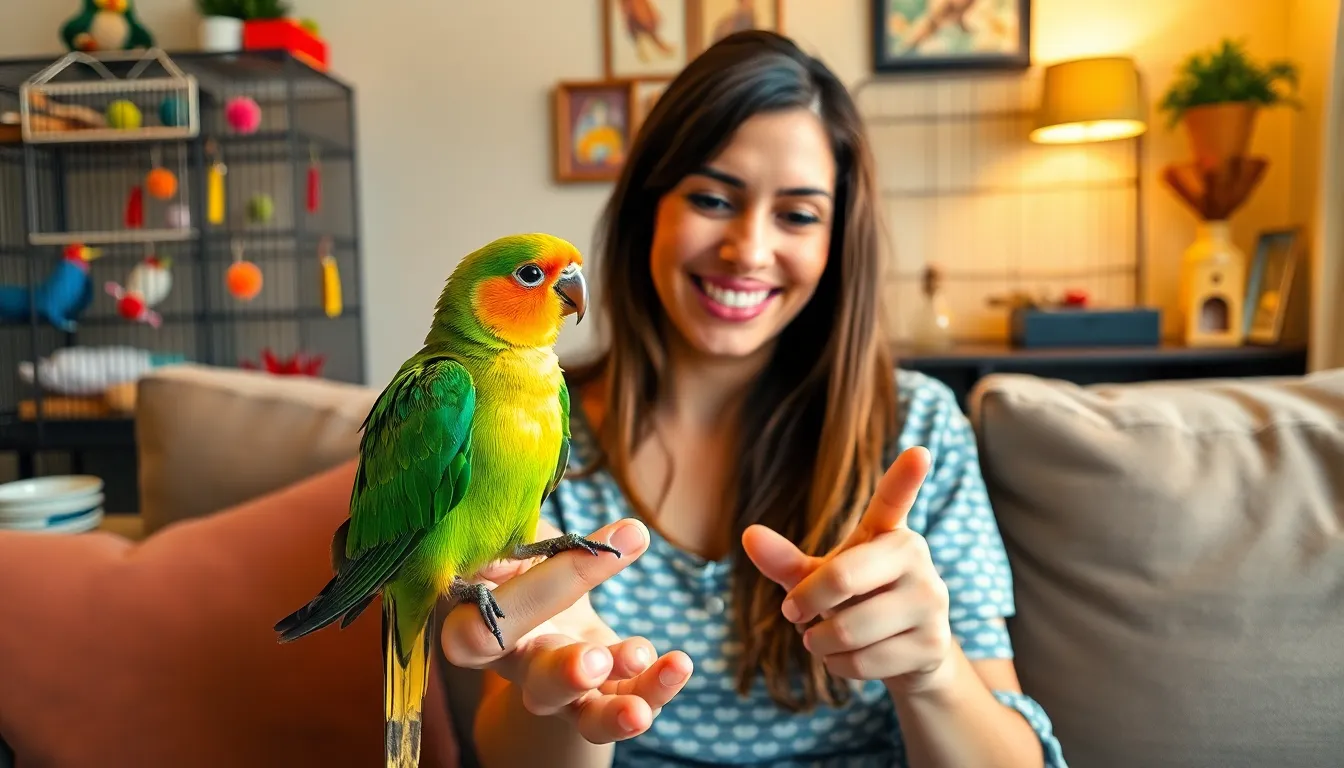
Training love birds creates stronger bonds with their human companions while promoting mental wellness. Proper enrichment activities prevent behavioral issues that commonly develop in understimulated birds.
Basic Training Techniques
Target training forms the foundation of love bird education using simple rewards and consistent commands. We start with basic step-up commands by offering our finger near their feet and saying “step up” in a calm voice. Positive reinforcement through millet spray treats or sunflower seeds motivates love birds to repeat desired behaviors.
Clicker training accelerates the learning process by creating clear communication between bird and trainer. The clicking sound marks the exact moment our love bird performs correctly followed immediately by a food reward. Daily training sessions lasting 5 to 10 minutes maintain their attention span while building trust.
Flight recall training teaches love birds to return when called during supervised out-of-cage time. We begin indoors with short distances of 2 to 3 feet gradually increasing range as confidence builds. Consistent verbal cues paired with hand signals create reliable recall responses that enhance safety during free flight periods.
Contact calls represent natural vocalizations we can redirect into useful communication tools. Love birds naturally call to locate flock members so we respond consistently to establish two-way communication patterns. Teaching exact whistle sequences for different situations like meal time or play time creates structured interaction routines.
Toys and Mental Stimulation
Foraging toys replicate natural feeding behaviors by hiding treats inside puzzle-like containers. Love birds spend 60% of their wild day searching for food so captive birds require similar mental challenges. We rotate 3 to 4 different foraging toys weekly to maintain novelty and prevent boredom.
Destructible toys satisfy their instinctual need to chew and shred materials for nest building. Paper cups, cardboard tubes, and untreated wood blocks provide safe outlets for natural behaviors. Fresh branches from apple, willow, or birch trees offer texture variety while supporting beak health through regular use.
Interactive puzzle toys challenge their problem-solving abilities through stackable rings, sliding panels, and removable parts. Love birds demonstrate intelligence levels comparable to a 3-year-old child so complex toys prevent cognitive decline. We observe which puzzle styles each bird prefers then provide similar variations.
Social enrichment activities include mirror time, music exposure, and supervised interaction with other household pets. Love birds respond positively to classical music and nature sounds played at moderate volumes during active hours. We limit mirror access to 15-minute sessions to prevent over-bonding with their reflection.
Environmental rotation transforms their living space through rearranged perches, new climbing structures, and seasonal decorations. Moving cage accessories weekly stimulates exploration behaviors and maintains territorial interest. Natural lighting changes throughout seasons require corresponding adjustments to their daily enrichment schedules.
Pros and Cons of Owning Love Birds
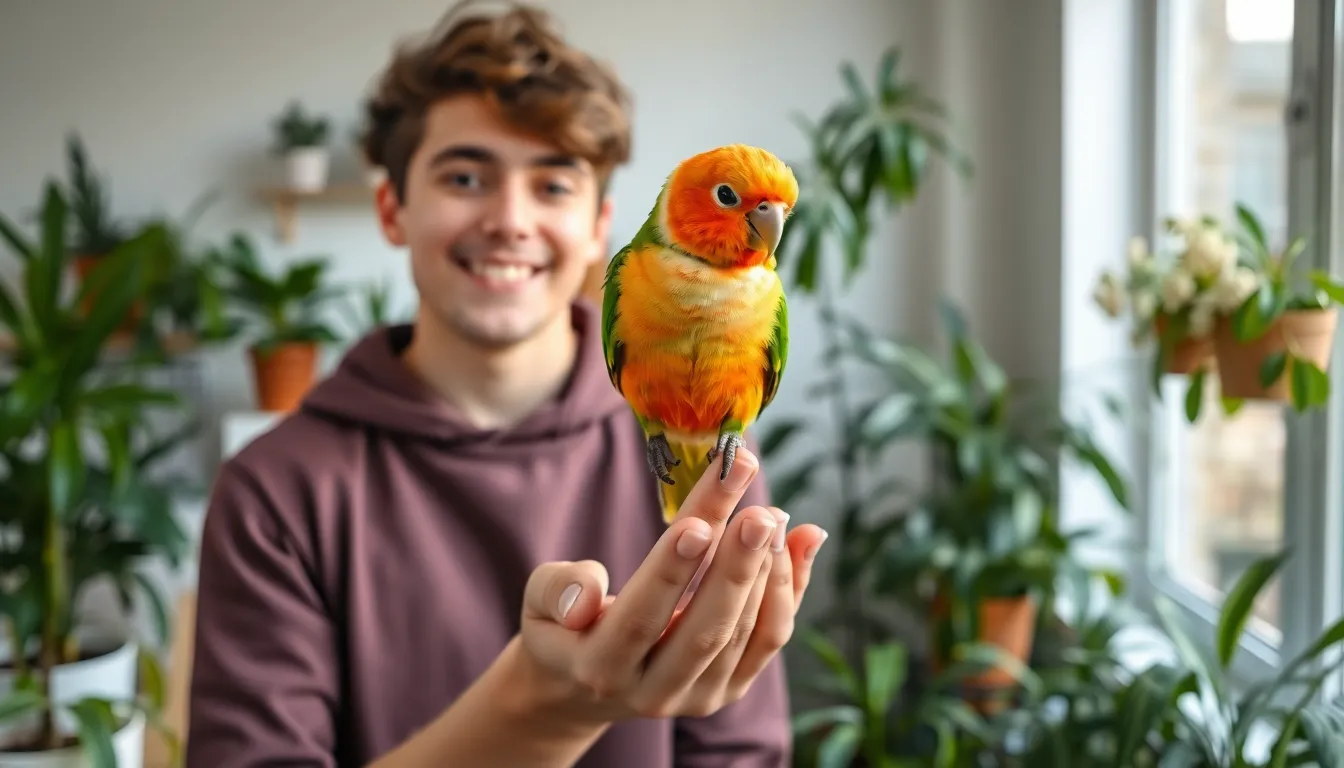
Owning love birds brings distinct advantages and challenges that potential owners must carefully consider before making this commitment.
Advantages of Love Bird Ownership
Companionship and Affection
Love birds form exceptionally strong bonds with their human caretakers, providing years of interactive companionship. These small parrots demonstrate their affection through gentle nibbling, preening their owner’s hair, and seeking physical closeness during daily interactions. Many owners report receiving enthusiastic greetings when returning home, as love birds recognize and respond positively to familiar voices and faces.
Manageable Size and Space Requirements
Their compact 5 to 7-inch frame makes love birds ideal for apartment living and smaller homes. Unlike larger parrot species, love birds thrive in appropriately sized cages without requiring entire rooms for housing. Their space efficiency allows urban dwellers to enjoy bird ownership without important home modifications or extensive square footage dedication.
Vibrant Colors and Visual Appeal
Love birds display spectacular color combinations that enhance any living space with natural beauty. Peach-faced varieties showcase brilliant orange and green plumage, while Fischer’s love birds exhibit striking blue and orange patterns. These visual characteristics provide constant aesthetic enjoyment and create captivating focal points within home environments.
Intelligence and Trainability
Love birds respond well to consistent training methods, learning target training and basic commands within weeks of regular practice. Their cognitive abilities allow them to recognize routines, respond to their names, and even learn simple tricks. Some peach-faced love birds develop limited vocabularies, mimicking common household sounds and short phrases.
Disadvantages of Love Bird Ownership
High Social Demands and Attention Requirements
Love birds require several hours of daily interaction to maintain psychological health and prevent behavioral problems. Neglected birds often develop destructive habits like excessive screaming, feather plucking, or aggressive territorial behaviors. Working professionals frequently struggle to meet these intensive social needs consistently.
Noise Levels and Vocalization Patterns
Love birds produce loud vocalizations during dawn and dusk periods, creating potential conflicts with neighbors in close living situations. Their natural calling behaviors can reach 80 decibels, equivalent to city traffic noise levels. Apartment dwellers may face noise complaints or lease violations due to these vocal expressions.
Veterinary Costs and Specialized Care
Avian veterinary services cost significantly more than traditional pet care, with routine checkups ranging from $75 to $200 per visit. Emergency treatments for conditions like egg binding or respiratory infections often exceed $500 to $1,000. Finding qualified avian veterinarians requires research, as many general practitioners lack specialized bird medicine training.
Longevity and Long-term Commitment
Love birds live 10 to 15 years in captivity, requiring consistent care throughout major life changes including relocations, career shifts, or family expansions. Their extended lifespan demands financial planning for decades of food, veterinary care, and housing expenses. Many owners underestimate this long-term responsibility when initially acquiring their birds.
Potential Health Risks and Disease Transmission
Love birds can transmit psittacosis to humans through respiratory droplets, causing flu-like symptoms that require antibiotic treatment. Their dust and dander may trigger allergic reactions in sensitive individuals. Regular cage cleaning and proper ventilation become essential health management practices for households with love birds.
Conclusion
Love birds truly make remarkable companions for those ready to embrace their unique needs and vibrant personalities. We’ve explored how these small parrots bring joy through their affectionate bonds strong social behaviors and stunning colors that brighten any home.
Their care requirements from proper housing and nutrition to regular veterinary attention might seem extensive but the rewards are immeasurable. We believe that understanding their natural behaviors breeding patterns and health needs helps create the foundation for a thriving relationship.
For those considering adding love birds to their family we encourage careful consideration of the long-term commitment involved. These intelligent creatures can live for decades and deserve owners who appreciate their complex social nature and are prepared to provide consistent care throughout their lives.
Frequently Asked Questions
What are love birds and how big do they get?
Love birds are small, colorful parrots from the genus Agapornis that measure 5 to 7 inches in length. They’re known for their intelligence, affectionate behavior, and striking color variations. These compact birds have strong zygodactyl feet and curved beaks that help them climb and feed effectively.
Where do love birds come from originally?
Love birds are exclusively native to Africa, where they thrive in diverse ecosystems ranging from savannas to tropical forests. They exhibit social behavior and seasonal migrations in their natural habitat, though human development has impacted some populations while others remain stable in protected areas.
What are the most popular love bird species for pets?
The three most popular species in the pet trade are peach-faced, Fischer’s, and masked lovebirds. Peach-faced lovebirds are the most common in captivity due to their adaptability and vibrant color mutations, while Fischer’s and masked lovebirds each have unique appearances and specific care requirements.
Do love birds really form strong pair bonds?
Yes, love birds form lifelong monogamous partnerships and engage in mutual preening and feeding behaviors. They also bond closely with their human caretakers and their natural flock dynamics influence their behavior, including territorial males defending nesting areas and females selecting nesting materials.
What kind of cage do love birds need?
Love birds require spacious cages with specific dimensions and appropriate bar spacing to accommodate their active nature. The cage should include essential accessories, proper environmental conditions like stable temperature and lighting, and be maintained daily to ensure optimal living conditions.
What should I feed my love birds?
Love birds need a diverse diet including high-quality pellets, fresh vegetables, and limited seeds. Avoid harmful foods like chocolate, avocado, caffeine, and certain fruit pits. Breeding pairs need calcium supplements, and fresh water should be provided daily to maintain proper nutrition.
What health problems do love birds commonly face?
Common health issues include respiratory infections, Psittacine Beak and Feather Disease (PBFD), egg binding, nutritional deficiencies, and crop stasis. Regular veterinary checkups, proper quarantine protocols, environmental hygiene, and stress reduction are essential for preventing these health problems.
Can love birds learn to talk or mimic sounds?
Some love bird species exhibit mimicry abilities, with peach-faced love birds showing the strongest aptitude for vocal learning. They communicate through various vocalizations ranging from soft chirps to loud squawks, and also use body language for communication with their companions.
How do love birds breed and what’s involved?
Love birds have complex reproductive behaviors with elaborate courtship rituals where males perform head bobbing displays and regurgitate food. Females construct nests and incubate eggs for 21 to 24 days. Successful breeding requires a high-protein diet and stable environmental conditions.
What are the pros and cons of owning love birds?
Pros include strong companionship, manageable size, vibrant colors, and intelligence. Cons include high social demands, potential noise levels, veterinary costs, long lifespan commitment, and health risks. Potential owners should carefully consider these factors before committing to love bird ownership.

